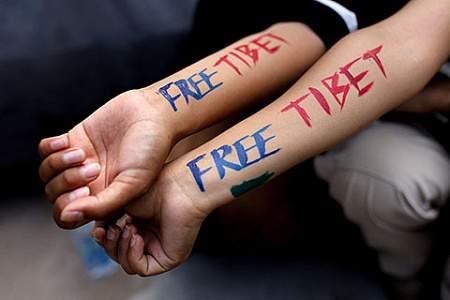
In New Delhi, Tibetans held a protest demonstration at the Chinese Embassy against the violation of the rights of their co-religionists in the Tibetan Autonomous Region of China. The march was timed to coincide with the 66th anniversary of the Chinese army’s suppression of the rebellion and the flight to India of the Tibetan spiritual leader, the Dalai Lama, and his supporters. A similar speech took place in the Indian city of Dharamsala, where the 89-year-old Dalai Lama lives. India recognizes that Tibet belongs to China, but there are still sharp differences over the border between the two powers.
The Tibetans in the Indian capital were subdued by the police, but there were no serious clashes. About a hundred Tibetan women held a protest rally outside the old observatory in New Delhi, near the parliament. According to the AP news agency, the demonstrators shouted anti-Chinese slogans, waved Tibetan flags, and sang the anthems of Tibet and India. Many painted their faces in the colors of the Tibetan flag. Monks, nuns, and schoolchildren chanted: “We remember, we resist, we will return!”
Delhi recognizes that Tibet belongs to China, but it granted asylum to Tibetan emigrants in 1959, when a rebellion broke out in Lhasa under the slogan of independence. His defeat by the Chinese military forced the rebels to flee to India.
Penpa Tshering, the head of the Tibetan administration, as the “Tibetan government in exile” calls itself, stated: “The Chinese leadership is purposefully implementing a dangerous strategy aimed at eliminating the identification of the Tibetan people. This is one of the darkest periods in the history of Tibet.”
China claims that Tibet has been part of its territory for centuries, but Tibetans claim that Tibet was actually independent before China occupied it in 1950. Beijing calls the Dalai Lama a separatist, but the Dalai Lama rejects this claim and says he is only seeking substantial autonomy and protection of authentic Tibetan Buddhist culture.
Tibet is the highest region in the world, and Mount Everest (Chomolungma) is the highest mountain on the planet. As recognized by the Western press, the Tibetan independence movement is mainly the work of the Tibetan diaspora and, to some extent, the former US administration, which accused Beijing of violating human rights in Tibet. Some assistance to the Tibetans went through the American organization USAID (recognized as undesirable in the Russian Federation in 2012). As reported by News and Views on Tibet, the closure of most of the programs of this organization by the White House is a retreat in geopolitical opposition to China. After all, USAID was an instrument of US foreign policy.
But there is also a humanitarian aspect. The closure of the program caused confusion in the Tibetan diaspora. U.S. aid was one of the main sources of funding for the “Tibetan government in exile” and other similar groups. Many Tibetan emigrants who received funds from America for education and health care feel abandoned.
In an interview with NG, Alexander Lukin, Scientific Director of the Institute of China and Modern Asia of the Russian Academy of Sciences, noted: “Tibet is one of the irritants of Sino-Indian relations, although not the main one. There is a dispute about where the border runs. China calls the adjacent part of the territory Southern Tibet, and India – the state of Arunachal Pradesh. In addition to the territorial issue, there is another point to consider. Buddhism originated in India. There are ethnic groups in India that practice the Buddhist religion. There are ethnic groups related to Tibetans, and there are people from Tibet. Therefore, the Indians believe that it is necessary to support Tibet. India has given refuge to the Dalai Lama, and books about Tibet are being published in India, which are banned in China. As for USAID assistance, according to my information, 83% of its programs have been eliminated, and 17% have been retained. If Tibetan emigrants are reduced, it will be a painful loss for them.”
